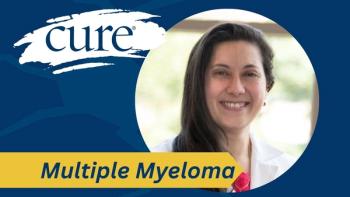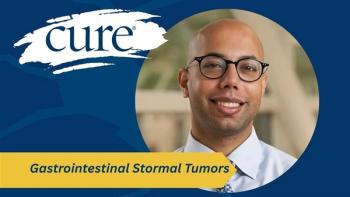Among patients with hormone receptor (HR)-positive, HER2-negative, high-risk early breast cancer, postsurgical, or adjuvant, Verzenio (abemaciclib) plus endocrine therapy was associated with a 15.8% reduction in the risk of death when compared with endocrine therapy alone, clinical trial results have shown.
Findings from the primary overall survival (OS) analysis of the phase 3 monarchE trial were presented at the 2025 ESMO Congress.
At a median follow-up of 76 months (6.3 years) and a data cutoff date of July 15, 2025, all patients had stopped receiving Verzenio for at least four years. There were 301 OS events in the Verzenio arm versus 360 in the endocrine therapy–alone arm. The OS rates at 60, 72 and 84 months were 91.2%, 89.2% and 86.8% in the Verzenio arm versus 90.2%, 87.9% and 85.% in the control arm.
Glossary
Overall Survival (OS): This is the length of time from diagnosis or the start of treatment that patients are still alive. It helps doctors understand how well a treatment may be working.
Invasive Disease–Free Survival (IDFS): This refers to the time after treatment during which a person has no signs of cancer coming back or spreading. It specifically focuses on more serious (invasive) cancer returning.
Distant Relapse–Free Survival (DRFS): This means how long a patient stays free from the cancer returning in other parts of the body (far from where it started), after finishing treatment.
Pharmacokinetics (PK): This is the study of how a medicine moves through the body—how it's absorbed, used, and cleared out. It helps doctors decide on the right dose and timing for treatment.
“[Verzenio] represents the first CDK4/6 inhibitor to achieve a statistically significant improvement in OS for these high-risk, node-positive patients,” Dr. Stephen Johnston stated in the presentation.
Johnston is head of the Breast Unit, a professor of breast cancer medicine, and a consultant medical oncologist at The Royal Marsden NHS Foundation Trust and The Institute of Cancer Research in London, United Kingdom.
What Was the Impetus for Conducting the monarchE Trial?
“Improving OS and cure rates is the goal of adjuvant therapy in early breast cancer, but it's difficult to prove OS, and we often approve treatments on benefits in reducing risk of recurrence,” Johnston explained.
He summarized key findings from the past several years of investigating endocrine therapy in patients with hormone receptor–positive early breast cancer, including reductions in the risk of death conferred by the use of tamoxifen versus no treatment, the use of an aromatase inhibitor (AI) versus tamoxifen, and the use of extended AI treatment versus 5 years of endocrine therapy. He noted that unlike in prior trials, previously reported data from monarchE indicated that an OS benefit could emerge from the addition of Verzenio to endocrine therapy versus endocrine therapy alone.
What Was the Design of the monarchE Trial?
monarchE enrolled patients with hormone receptor–positive, HER2-negative, mode-positive, high-risk early breast cancer. Cohort 1 included patients with high-risk disease based on clinical and pathological factors, including at least four positive axillary lymph nodes or one to three positive axillary lymph nodes and grade 3 disease and/or a tumor size of at least 5 cm. Cohort 2 included patients with high-risk disease based on Ki-67 score, defined as one to three positive axillary lymph nodes plus a Ki-67 score of at least 20%, as well as grade 3 or lower disease and a tumor size of less than 5 cm.
Patients in cohort 1 (5,637 patients) were randomly assigned to receive Verzenio at 150 mg twice daily plus endocrine therapy or endocrine therapy alone for the on-treatment study period of two years. During the follow-up period, patients received endocrine therapy for three to eight years as clinically indicated. Patients were stratified by prior chemotherapy, menopausal status and region.
The primary end point was invasive disease–free survival (IDFS). Secondary end points included IDFS in the high Ki-67 populations, distant relapse–free survival (DRFS), OS, safety, pharmacokinetics, and patient-reported outcomes.
What Data Have Been Previously Reported From monarchE?
The initial readout of the monarchE trial showed that patients who received two years of adjuvant Verzenio plus endocrine therapy had significant improvements in IDFS compared with those who received endocrine therapy alone. Furthermore, at the five-year landmark analysis of the trial, at a median follow-up of 54 months, the IDFS and DRFS benefits with Verzenio were sustained, and an OS trend favoring the Verzenio arm had emerged, although it had not yet reached statistical significance.
What Additional Data Were Seen in the Primary OS Analysis of monarchE?
In the primary OS analysis, the OS benefit with the addition of Verzenio was consistent across prespecified patient subgroups. However, Johnston emphasized that the point estimates for the individual subgroups should be interpreted with caution because the trial was not powered or controlled to evaluate treatment effects in individual subgroups.
There were approximately 30% fewer patients living with metastatic disease in the Verzenio arm versus the control arm. In the Verzenio arm, 2.8% of patients (n = 80) had died from causes unrelated to breast cancer, 7.9% of patients (n = 221) had died due to breast cancer, and 6.4% of patients (n = 180) were alive with metastatic disease. In the control arm, these rates were 2.3% (n = 64), 10.5% (n = 296), and 9.4% (n = 266), respectively.
The addition of Verzenio to endocrine therapy reduced the risk of IDFS events by 26.6% compared with endocrine therapy alone. There were 547 and 722 IDFS events in these respective arms.
During the follow-up period, the respective IDFS rates in the Verzenio and control arms were as follows:
- 24 months: 92.7% versus 89.9%
- 36 months: 89.2% versus 84.4%
- 48 months: 85.9% versus 80.0%
- 60 months: 83.1% versus 76.5%
- 72 months: 80.0% versus 74.1%
- 84 months: 77.4% versus 70.9%
A consistent IDFS benefit was observed across all prespecified subgroups.
Johnston noted that most IDFS events observed in the trial were distant metastatic disease, and that the addition of Verzenio reduced the number of patients with metastases at common sites. In the Verzenio arm (2,808 patients), 18% of patients in the intent-to-treat (ITT) population had a first recurrence, consisting of distant recurrence (13.6%), local/regional recurrence (2.5%), second primary neoplasm (1.7%) and contralateral breast cancer (0.5%). The sites of initial distant recurrence in this arm included bone (5.9%), liver (3.5%), lung (2.5%), brain/central nervous system (CNS; 1.1%), lymph node (1.0%) and pleura (0.3%).
In the control arm (2,829 patients), 24.5% of patients in the ITT population had a first recurrence, consisting of distant recurrence (18.5%), local/regional recurrence (3.9%), second primary neoplasm (1.8%) and contralateral breast cancer (0.8%). The sites of initial distant recurrence in this arm included bone (9.4%), liver (4.7%), lung (2.7%), brain/CNS (1.1%), lymph node (1.6%) and pleura (1%).
Overall, investigators observed low rates of second primary neoplasms across both arms.
A sustained DRFS benefit with the addition of Verzenio was also observed, reducing the risk of DRFS events by 25.4% compared with endocrine therapy alone. There were 476 DRFS events in the Verzenio arm versus 621 DRFS events in the control arm.
During the follow-up period, the respective DRFS rates in the Verzenio and control arms were as follows:
- 24 months: 94.0% versus 91.5%
- 36 months: 90.9% versus 86.6%
- 48 months: 88.2% versus 83.1%
- 60 months: 85.4% versus 79.5%
- 72 months: 82.6% versus 77.6%
- 84 months: 80.0% versus 74.9%
The investigators also reported a consistent DRFS benefit with Verzenio across prespecified subgroups.
Among patients in the Verzenio arm with distant recurrence who entered the post-two-year treatment follow-up period (407 patients), 78.9% received any first systemic therapy in the first-line metastatic setting, 32.7% received chemotherapy, 46.7% received endocrine therapy, 33.2% received targeted therapy (CDK4/6 inhibitor, 30.0%; PI3K/AKT/mTOR inhibitor, 3.2%) and 5.2% received other therapy. These respective rates in the control arm (565 patients) were 83.4%, 23.7%, 58.4%, 484.8% (CDK4/6 inhibitor, 47.3%; PI3K/AKT/mTOR inhibitor, 0.7%) and 4.8%.
Differences in CDK4/6 inhibitor and chemotherapy use between the arms were predominantly seen among patients with early recurrences and were less pronounced among those with later recurrences. Among patients with early recurrences, the rates of chemotherapy and CDK4/6 inhibitor use were 43.5% and 15.2%, respectively, in the Verzenio arm (191 patients) versus 26.8% and 44.7%, respectively, in the control arm (313 patients). Among patients with late recurrences, the usage rates of these respective classes of therapy were 23.1% and 43.1% in the Verzenio arm (216 patients) versus 19.8% and 50.4% in the control arm (252 patients).
“This makes clinical sense,” Johnston reported. “Patients relapsing on their adjuvant CDK4/6 inhibitor may be more likely to be offered chemotherapy. Those who have not had it in the adjuvant setting may be offered it for their metastatic disease. Remember, this was a global trial. Investigators could treat the patients as they saw fit. Globally, not all therapies in metastatic disease are equally available around the world, so we do not believe that this analysis confounds the OS impact we've seen. If there were more CDK4/6 inhibitors [used] in the endocrine therapy–alone arm, that might diminish the OS benefit, not enhance it.”
What Were the Long-Term Safety Findings From monarchE?
Safety results from long-term follow-up were consistent with those from prior analyses, because all treated patients had completed treatment at least four years prior. Investigators observed no relevant differences in side effect–related causes of death between the two arms.
Among safety-evaluable patients in the Verzenio arm (2,791 patients), during therapy, 15 deaths occurred; the most common causes of death were infections and infestations (COVID-19, three patients) and cardiac disorders (five patients). Following treatment discontinuation in this arm, 197 patients had at least one serious side effect during late-term follow-up, regardless of causality. There were 44 deaths attributed to side effects, including infections and infestations (13 patients; COVID-19, six patients), second primary neoplasm (13 patients) and cardiac disorders (six patients).
Among safety-evaluable patients in the control arm (2,800 patients), during therapy, 11 deaths occurred; the most common causes of death were infections and infestations (five patients; COVID-19, one patient) and second primary neoplasm (one patient). Following treatment discontinuation in this arm, 213 patients had at least one serious side effect during late-term follow-up, regardless of causality. There were 30 deaths attributed to side effects, including infections and infestations (five patients; COVID-19, two patients), second primary neoplasm (seven patients) and cardiac disorders (nine patients).
“The seven-year analysis has continued to show a sustained benefit in IDFS and DRFS, and there are no new safety signals,” Johnston concluded.
References
- “Overall survival with abemaciclib in early breast cancer” by Dr. Stephen Johnston, et al. Ann Oncol.
- “Abemaciclib combined with endocrine therapy for the adjuvant treatment of HR+, HER2-, node-positive, high-risk, early breast cancer (monarchE)” by Dr. Stephen Johnston, et al.J Clin Oncol.
- “Adjuvant abemaciclib plus endocrine therapy for hormone receptor-positive, human epidermal growth factor receptor 2-negative, high-risk early breast cancer: results from a preplanned monarchE overall survival interim analysis, including 5-year efficacy outcomes” by Dr. Priya Rastogi et al., J Clin Oncol.
For more news on cancer updates, research and education, don’t forget to subscribe to CURE®’s newsletters here.






